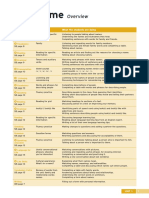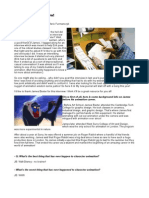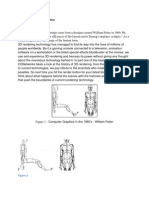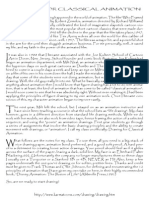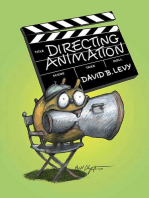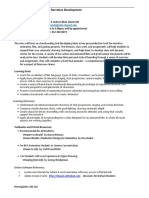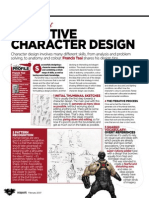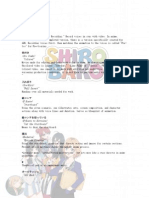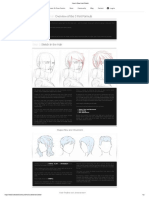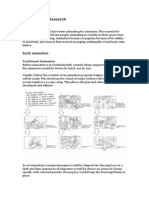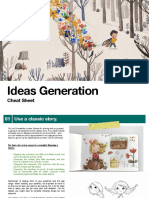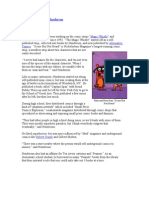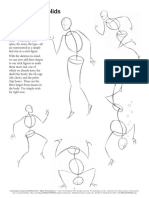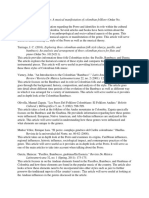Character Animation
Character Animation
Uploaded by
BAAIMDocsCopyright:
Available Formats
Character Animation
Character Animation
Uploaded by
BAAIMDocsCopyright
Available Formats
Share this document
Did you find this document useful?
Is this content inappropriate?
Copyright:
Available Formats
Character Animation
Character Animation
Uploaded by
BAAIMDocsCopyright:
Available Formats
RMIT Concept and Character Development For Animation Lecturer: Simon Norton Email: simon.norton@rmit.edu.au Website: www.myballoonhead.
com
CHARACTER IN ANIMATION
DISCLAIMER: Opinions contained within these course notes are those of the author only, and are to be taken as advice only. In other words, if you have a great idea that contradicts the advice herein, go ahead with it. Take the ideas you can use from these notes and adapt them to your own purposes. END DISCLAIMER
ANIMATION is used in animated films and television shows, but also on websites, in computer games, and in educational software. Animation is created in a variety of specific forms; Drawn, Clay, Puppet, Stop-Motion, 3D Computer Generated, and other less widely known techniques, such as Sand, Paint, and Cut-Out animation. However,whatever the animation style, the same general principle applies; Interesting Character = Interesting Story = Interesting Animation Boring Character = Boring Story = Boring Animation (Note: There are obvious exceptions; Some animation is purely visual abstraction and does not include any characters or story; this kind of animation is usually called Motion Graphics or Special Effects.)
So - what is the difference between an interesting character and a boring character? Essentially, and as a general rule, interesting characters ACT, rather than being simply acted upon. Interesting characters have distinct drives, wants, needs and preferences which drive the story and affect the way they behave. Interesting characters are doers. Interesting characters are active rather than passive, even if that action might be in a cowardly or avoidance-based direction.
RMIT Concept and Character Development For Animation Lecturer: Simon Norton Email: simon.norton@rmit.edu.au Website: www.myballoonhead.com
Good characters write their own stories Chuck Jones
(creator: Road Runner, Coyote, Pepe Le Pew, Claude Cat, Frisky Puppy, Marvin the Martian)
By this, Jones means that with a good character, the writer can place that character in absolutely any story situation, and the nature of the character will tell the writer how this particular character will react in this particular situation. What would Bugs Bunny do if he was in Aladdins cave? What would Daffy Duck do? The answers to these questions created Jones Ali Baba Bunny
What would Homer do if he was minding Mr Burns house? Is it different to what Lisa would do? Or what Bart would do? Obviously it is; they are distinctly different characters.
RMIT Concept and Character Development For Animation Lecturer: Simon Norton Email: simon.norton@rmit.edu.au Website: www.myballoonhead.com
EXERCISE 1 WRITING YOUR CHARACTERS BIOGRAPHY
BIOGRAPHY:
AGE: GENDER: HEIGHT: WEIGHT: BODY TYPE: FACE TYPE: COMPLEXION: EYES: HAIR: CLOTHING STYLE: SPEAKING STYLE: GENERAL DEMEANOR: CAREER: PREJUDICES:
BEST QUALITIES:
WORST QUALITIES:
WEAKNESSES:
HOBBIES:
TALENTS:
RMIT Concept and Character Development For Animation Lecturer: Simon Norton Email: simon.norton@rmit.edu.au Website: www.myballoonhead.com CULTURAL/ETHNIC BACKGROUND: IQ SOCIAL STATUS
FAMILY (parents, siblings, spouse, children)
FRIENDS AND OR ENEMIES
FEARS
STRONGEST MEMORY
HOPES AND DREAMS
NAME:
Note: Its very rare for a good character to have all these traits completely worked out straight away - Good characters often develop over time as dimensions are added for example the early Homer Simpson was more of a one-dimensional goofy buffoon, early Bugs Bunny more of a zany trickster.
RMIT Concept and Character Development For Animation Lecturer: Simon Norton Email: simon.norton@rmit.edu.au Website: www.myballoonhead.com
The importance of sketchbook doodles
Its important to realise that many great characters come out of a lot of time spent doodling, playing around with very rough and simple shapes and proportions. For example, below is a series of 1969 sketches by Jim Henson.
from the book Jim Hensons Designs and Doodles
And here is how the characters he was designing turned out;
RMIT Concept and Character Development For Animation Lecturer: Simon Norton Email: simon.norton@rmit.edu.au Website: www.myballoonhead.com
Like the character traits; its very rare to get a good characters visual design exactly right straight away its a process like sculpting, with gradual smoothing and adjusting, trying out different things. Even then, after the design is supposedly finished, a long-lasting character will often still develop over time.
The Simpsons now (left) and in 1987 (right)
Bugs Bunny in the 1930s (left) and in the 1950s (right)
RMIT Concept and Character Development For Animation Lecturer: Simon Norton Email: simon.norton@rmit.edu.au Website: www.myballoonhead.com
EXERCISE 2 DOODLING (in a spirit of experimentation) multiple variations of your character. Doodling means trying out all kinds of shapes and proportions and not simply copying the finished designs of other animators. This is where you try out all kinds of things, just to see if anything interesting results. Its important not to lock yourself in to a specific design right away deciding on an exact look comes later. Dont forget about trying out all the subtly different effects you can get out of the same material, simply by changing the positions and proportions of the same features.
RMIT Concept and Character Development For Animation Lecturer: Simon Norton Email: simon.norton@rmit.edu.au Website: www.myballoonhead.com
So - Which should go first, developing the character traits conceptually in writing, or the doodling? Should image follow concept, or concept follow image? Theres no one answer to this. Many independent animators prefer to intuitively doodle until they have a character who intrigues them, and then develop a personality, character traits, and story to suit the doodle. However, an animator does not always get to choose the type of character he or she must work with. Often the animator will be given a character type, like a nice little girl, or a cowardly dragon. In which case, the animator must create doodles of character designs to fit the given characters personality; ideally continuing to develop those personality traits in the process. Its best to be able to work both ways, because the animation production process can vary.
TYPICAL ANIMATION PROCESS TIMELINE (with variations indented) (Voice Recording for improvised scripts eg. Aardmans Creature Comforts) (Character Doodles?) CHARACTER IDEA AND DEVELOPMENT CHARACTER DOODLES STORY IDEA SCRIPT (but some animators eg John K, prefer to write in storyboard form) VOICE RECORDING & EDITING (but can also be done after character design, or as late as animatic) CHARACTER DESIGN (Voice recording?) STORYBOARDING ANIMATIC - rough version of animation featuring only key drawings ANIMATION PENCIL TESTS (if budget and timeline permit) ANIMATION (Voice recording? Usually only Japan or Cheapo) CLEANUP / COLORING / SOUND EFFECTS / SOUND MIX MASTERING
You might also like
- Imagine - Pentatonix Full ArrangementDocument14 pagesImagine - Pentatonix Full ArrangementMartin Andryas Littik100% (1)
- Animated Performance Sample Chapter 'Design For Living'Document28 pagesAnimated Performance Sample Chapter 'Design For Living'AVAAcademiaNo ratings yet
- Foundations in Comic BookDocument1 pageFoundations in Comic Book123No ratings yet
- The Wonderling by Mira Bartok Chapter SamplerDocument43 pagesThe Wonderling by Mira Bartok Chapter SamplerCandlewick PressNo ratings yet
- Game Design Document Personal ProjectDocument3 pagesGame Design Document Personal Projectapi-657335290No ratings yet
- American Inside Out Evolution Pre-Intermediate TBDocument12 pagesAmerican Inside Out Evolution Pre-Intermediate TBcentrorecreativosdc100% (3)
- Libro. THE ILLUSION OF LIFE DISNEY ANIMATION - Frank Thomas, Ollie Johnston - Tienda TeatralDocument6 pagesLibro. THE ILLUSION OF LIFE DISNEY ANIMATION - Frank Thomas, Ollie Johnston - Tienda TeatralDavid NeiraNo ratings yet
- James Baxter InterviewDocument5 pagesJames Baxter InterviewArturo Hernández CorreasNo ratings yet
- The History of 3D AnimationDocument11 pagesThe History of 3D AnimationAariff AlaviNo ratings yet
- How To Color Manga With Photoshop Part 1 & 2Document26 pagesHow To Color Manga With Photoshop Part 1 & 2Kishiwada Daichi Yamato100% (1)
- Drawing Lessons AnimationDocument35 pagesDrawing Lessons AnimationNipun ChordiyaNo ratings yet
- Character DesignDocument9 pagesCharacter DesignBAAIMDocs100% (4)
- Drawing Superheroes in Action Book II - (A Guide to Drawing Body Movements) For the Absolute BeginnerFrom EverandDrawing Superheroes in Action Book II - (A Guide to Drawing Body Movements) For the Absolute BeginnerRating: 1 out of 5 stars1/5 (1)
- Animated Scene PlanningDocument2 pagesAnimated Scene Planningapi-539931780No ratings yet
- ANI 220 Storyboarding and Narrative Development Syllabus: Winter 2018Document6 pagesANI 220 Storyboarding and Narrative Development Syllabus: Winter 2018Jjfreak ReedsNo ratings yet
- 2D Character Animation Study GroupDocument10 pages2D Character Animation Study GroupMarcrobin CabatoNo ratings yet
- 2D Animation-Syllabus "Movement Is The Outer (Physical) Result of Inner (Mental) Impulses."Document8 pages2D Animation-Syllabus "Movement Is The Outer (Physical) Result of Inner (Mental) Impulses."Gaby NunezNo ratings yet
- Character DesignDocument21 pagesCharacter Designcikinismail100% (2)
- Cartoon FundamentalsDocument30 pagesCartoon FundamentalsM Thali VR100% (1)
- Character and Creature Design Notes: Foot (And Shoe) Reference Part 2Document7 pagesCharacter and Creature Design Notes: Foot (And Shoe) Reference Part 2José GonzalesNo ratings yet
- Tutorial 2 CharacterDocument4 pagesTutorial 2 CharacterRian Setiawan HamidjoyoNo ratings yet
- Oscar Caprist O: How To Create Compelling CharactersDocument12 pagesOscar Caprist O: How To Create Compelling CharactersMyron McClellanNo ratings yet
- Exploring Drawing For Animation PDFDocument2 pagesExploring Drawing For Animation PDFKendraNo ratings yet
- Animation Exercises PDFDocument5 pagesAnimation Exercises PDFMarco Dos SantosNo ratings yet
- Animation TipsDocument12 pagesAnimation TipsBiancaNo ratings yet
- Visual Development FileDocument27 pagesVisual Development FileMegan LutchmayaNo ratings yet
- Sampe SkethingDocument21 pagesSampe SkethingPhuong Nguyen BichNo ratings yet
- 2D Animation HistoryDocument3 pages2D Animation HistoryNoraine TugadeNo ratings yet
- Shirobako WordsDocument12 pagesShirobako WordsflubbityfloopNo ratings yet
- Character Design: VillainDocument2 pagesCharacter Design: VillainAnthony DukeNo ratings yet
- 12 Principles of Animation LinksDocument3 pages12 Principles of Animation Linksapi-249887062No ratings yet
- How To Format A Comic ScriptDocument5 pagesHow To Format A Comic ScriptpentayNo ratings yet
- Editorial CartooningDocument31 pagesEditorial CartooningMily AllenNo ratings yet
- How To Draw Hair SketchDocument2 pagesHow To Draw Hair SketchMayLiuNo ratings yet
- How To Draw Manga - Hands and FeetDocument5 pagesHow To Draw Manga - Hands and Feetannibalinotherealone100% (8)
- Eric LarsonDocument16 pagesEric LarsonMārs LaranNo ratings yet
- Learn Clip Studio Paint: A beginner's guide to creating compelling comics and manga artFrom EverandLearn Clip Studio Paint: A beginner's guide to creating compelling comics and manga artNo ratings yet
- Jaykittens, Background Device, IllustrationDocument35 pagesJaykittens, Background Device, IllustrationBruna TestoniNo ratings yet
- The Animators Checklist - by Howard Wimshurst 1 PDFDocument12 pagesThe Animators Checklist - by Howard Wimshurst 1 PDFljdokigtmmpomeqzepawdrtorgNo ratings yet
- Aniamtion BooksDocument3 pagesAniamtion BooksPriyam ChakrabortyNo ratings yet
- Syn Studio Concept Art Diploma: Application GuideDocument6 pagesSyn Studio Concept Art Diploma: Application Guidebharat0072No ratings yet
- Animations Books ViveckDocument1 pageAnimations Books ViveckVivek KumarNo ratings yet
- Animation GlossaryDocument5 pagesAnimation GlossarypudelhsdNo ratings yet
- 2d Animation ResearchDocument4 pages2d Animation Researchapi-239352145100% (1)
- U2 - 03 - Analysing Mood Board Cheat SheetDocument4 pagesU2 - 03 - Analysing Mood Board Cheat SheetMuhammad Bobby BangsawanNo ratings yet
- How To Draw Cartoon NinjaDocument7 pagesHow To Draw Cartoon Ninjachiang13No ratings yet
- U2 04 Ideas Generation Prompt SheetDocument5 pagesU2 04 Ideas Generation Prompt SheetMuhammad Bobby BangsawanNo ratings yet
- What Is The Difference Between 2D and 3DDocument6 pagesWhat Is The Difference Between 2D and 3DAnthony Lawrence50% (2)
- Character DesignDocument16 pagesCharacter DesignEleanorNo ratings yet
- Entertainment IV: "Drawing For Animation" by Eric LarsonDocument4 pagesEntertainment IV: "Drawing For Animation" by Eric LarsonShanmuga SundarNo ratings yet
- Animation Story PDFDocument15 pagesAnimation Story PDFHasan MarufNo ratings yet
- Chatting With Sam HendersonDocument4 pagesChatting With Sam HendersonEdward Carey100% (1)
- Curriculum of Manga CourseDocument10 pagesCurriculum of Manga CourseRyan ƁoŋŋęrNo ratings yet
- Fzdschool Com Blog Posts Creating Worlds With Form Follows FDocument25 pagesFzdschool Com Blog Posts Creating Worlds With Form Follows Fncco rccsNo ratings yet
- Estructura de La Figura HumanaDocument14 pagesEstructura de La Figura HumanaJon LotinaNo ratings yet
- Animation Art - Electric Pencil ProductionsDocument60 pagesAnimation Art - Electric Pencil ProductionsJose Mario Gentil Ramos100% (1)
- Visual Development/Concept Art AdvancedDocument6 pagesVisual Development/Concept Art AdvancedMayank MauryaNo ratings yet
- Post-Production FlowchartDocument1 pagePost-Production FlowchartBAAIMDocsNo ratings yet
- Introduction To VideoDocument10 pagesIntroduction To VideoBAAIMDocsNo ratings yet
- Lecture Notes: BAAIM CamerasDocument11 pagesLecture Notes: BAAIM CamerasBAAIMDocsNo ratings yet
- CELTXDocument12 pagesCELTXBAAIMDocsNo ratings yet
- 2D - Assignment 2Document3 pages2D - Assignment 2BAAIMDocsNo ratings yet
- Story ConceptsDocument5 pagesStory ConceptsBAAIMDocsNo ratings yet
- Sound Energy PDFDocument8 pagesSound Energy PDFJim Boy SantokNo ratings yet
- Symphony X - of Sins and Shadows (Solo Michael Romeo)Document11 pagesSymphony X - of Sins and Shadows (Solo Michael Romeo)Fernando MoreiraNo ratings yet
- Understanding Piezoelectric Quartz CrystalsDocument5 pagesUnderstanding Piezoelectric Quartz CrystalsfabirznNo ratings yet
- Mptoklax PDF 1714949247Document37 pagesMptoklax PDF 1714949247Mauricio Acevedo GarciaNo ratings yet
- Silence Court Is in Session .... Dramatic TechniqueDocument3 pagesSilence Court Is in Session .... Dramatic TechniqueAnanya RayNo ratings yet
- Hfe Sennheiser PXC 150 Flyer enDocument2 pagesHfe Sennheiser PXC 150 Flyer enRafael CordanoNo ratings yet
- Sco 2080r 1 Manual UtilizareDocument19 pagesSco 2080r 1 Manual Utilizareyacp16761No ratings yet
- Unit-I Wireless Communication FundamentalsDocument25 pagesUnit-I Wireless Communication FundamentalsAbirami ManiNo ratings yet
- 1KHW001489-EN Instruction Manual ETL600 Rel.3.2 (Dec 2008, Annex Jan 2010) PDFDocument480 pages1KHW001489-EN Instruction Manual ETL600 Rel.3.2 (Dec 2008, Annex Jan 2010) PDFgam2312No ratings yet
- Favorite Books and MoviesDocument5 pagesFavorite Books and MoviesanatpozilovNo ratings yet
- We Are The Champions - Choir-Full ScoreDocument4 pagesWe Are The Champions - Choir-Full ScoreGamaliel Pagán Hernández67% (3)
- Colombian Traditional Music Annotated BibliographyDocument2 pagesColombian Traditional Music Annotated BibliographyJP CastilloNo ratings yet
- Dissertation HellwigDocument5 pagesDissertation HellwigPaySomeoneToWritePaperSaintPaul100% (1)
- 2019 Sa GN Obc 1Document35 pages2019 Sa GN Obc 1SahithiNo ratings yet
- 12 Tama CatalogDocument21 pages12 Tama CatalogSergio Lozano HernandezNo ratings yet
- 64 Vibroverb Custom ManualDocument20 pages64 Vibroverb Custom ManualAlexandre S. CorrêaNo ratings yet
- Music Instrument Repair Request: VENDOR: Music & Arts (Guitar Center Stores, Inc.)Document1 pageMusic Instrument Repair Request: VENDOR: Music & Arts (Guitar Center Stores, Inc.)Zachary GomezNo ratings yet
- DOS MUCHACHOS-PianoDocument3 pagesDOS MUCHACHOS-PianoMateusz KrasNo ratings yet
- Ap09 ManualDocument7 pagesAp09 ManualChevo SanchezNo ratings yet
- ?urriculum - Vitae: Santosh KumarDocument5 pages?urriculum - Vitae: Santosh KumarSantosh KumarNo ratings yet
- Family GuyDocument5 pagesFamily GuyRAMOS, Jann Julianne D.No ratings yet
- Music SA Dhol and TaikoDocument2 pagesMusic SA Dhol and Taikotajree321No ratings yet
- "The Creation": T H E Choral UnionDocument8 pages"The Creation": T H E Choral UnionHillahNo ratings yet
- Early Modern English LiteratureDocument10 pagesEarly Modern English LiteratureZarifa Taneer ChowdhuryNo ratings yet
- GT30 ManualDocument83 pagesGT30 ManualJerry ReddenNo ratings yet
- Rich Media WhitepaperDocument6 pagesRich Media Whitepapersdg_20049316No ratings yet
- Panis Angelicus: Trumpet I in B BDocument5 pagesPanis Angelicus: Trumpet I in B BLuis GutiérrezNo ratings yet





